Snow Stomper
Team: Dave Carr, Hridyesh Mangalath, Philippe Meister, Michael Olk, Shekoofe Saadat
Summary
Snow removal results in 12,000 annual accidents in the United States. Of the 12,000 accidents, 34.3% include strain on the lower back tissue due to overextension (Watson et. al. 2011). There are back-friendly snow-removal tools on the market, but none reduce strain on the back by empolying leg muscles. The Snow Stomper employs the leg muscles to lift snow. The Snow Stomper was tested with 5 participants and it decreased muscle activity in the lower back and increased muscle activity in the leg; however, the moment across the L5S1 joint are larger than for a standard shovel. Future work can focus on reducing the moment arm of the Snow Stomper while retaining functionality.
Introduction
In the united states, 85% of the workforce will experience lower back pain in their lifetime. Lower-back incidents result in an estimated 12 restricted work days. If the symptoms continue for six months, less than half of the workers will ever return to the same job (Andersson GBJ, 1999). Snow removal is an activity that results in many lower back strains in industry and at home. About 12,000 incidents related to snow shoveling are reported to the emergency rooms in the United States per year, with over 34.3% injuries including a strain of the back soft tissues due to over extension (Watson et. al., 2011). Previous research into lower back strains recommends that people "squat lift" compared to "stoop lift" in order to engage quadricep muscles instead of lower back muscles (Anderson, at, al. 1986; Barzegari, et, al. 2007). While the lifting reccomendations are useful, there are opportunites to redesign snow removal tools to better employ leg muscles to lift snow.
Approach
We developed design requirements by interveiewing potential users of the tool. We interviewed 10 people who are responsible for snow removal at their private residences about their snow removal practices. The interviews to generated requirements for a snow removal tool that employs leg muscles. Requirements for this tool include: (1) decrease strain on back (2) usable for 45 minutes with minimal breaks (3) cost less than $100 (4) be human-powered.
Design
We developed the Snow Stomper through task analysis, combination tables, and a Harris Profile.
Task Analysis
The task analysis identified four bodily tasks during the potential users' snow shoveling. The four stages are:
- Push and/or scoop
- Lift
- Dump or throw
- Repeat
Combinations
We isolated each stage and generating concepts that would satisfy the goal of that stage. Our concepts maintained the aim of eventually developing a manual snow removal concept that utilizes the power of the lower body. Our method of generating concepts for each stage was brainwriting. Brainwriting entails a group of 4-5 individuals each starting with a blank piece of paper and silently generating one concept through illustration or writing for the agreed criteria. Ideas are put in the center of the table called the “pool” and other participants can pull out ideas from the pool and build off of them. This facilitates the process of building off of other people’s ideas to create new solutions. We held three sessions; one for each stage of the manual snow removal process. After the primary ideation phase, we configured all the fundamental concepts into a combination table. The goal of the combination table was to generate concepts for each stage that would act as fragments to then systematically piece together to create a plausible solution for our problem statement (Eppinger 134).
| a (push/scoop) | b (lift) | c (dump/throw) | |
|---|---|---|---|
| 1 | Bin | Air bladder | Wheelbarrow |
| 2 | Wheelbarrow | Crank | Sand box (2 levers) |
| 3 | Conveyor belt | Double hand lever | Foot pedals |
| 4 | Straight bar | Single leg lever | Flexible |
| 5 | Push on wheels | Leg lever | Swivel 2 part |
| 6 | Skid | Conveyor lever | Swivel 1 part |
| 7 | Whale | Crank ratchet | Brake cable release |
| 8 | Activator | ||
| 9 | Clamshell |
With the fragments listed out underneath their respective stage, we took time to silently create formulas that would represent a potential, complete concept. It was understood between all group members to eliminate any combinations that do not make sense. The formulas of the concepts were written on the white board and initialed and discussed. This resulted in a list of possible combinations generated by individual team members.
Downselection
A process of down-selection was conducted to eliminate combinations that were not viable as solutions. The process resulted in three possible solutions. To further evaluate the three solutions, we visualized the solutions with computer-aided design (CAD) tools.
The Single Swivel Shovel had three wheels and an attached shovel. The design includes a lever for the lower-body-powered lifting. The dumping on this design is done by twisting the shovel, resulting in the snow sliding off from either side of the shovel head.
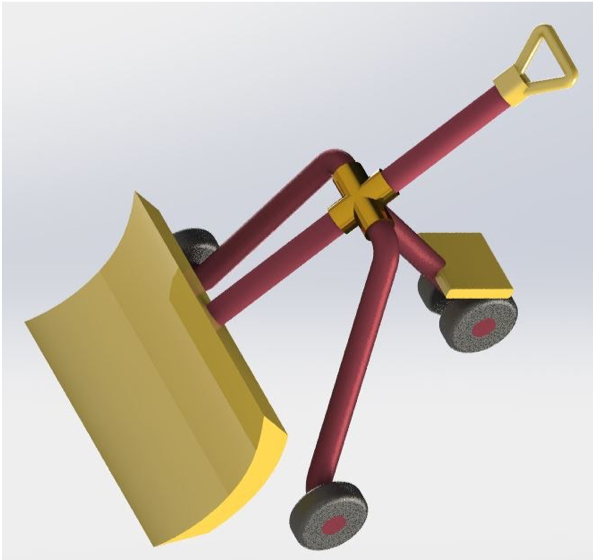
The Dual Swivel Shovel had three wheels and two attached shovels. This design also includes a foot lever to allow for lower-body-powered lifting. Dumping on this design is done by twisting the shovels, resulting in the snow sliding off towards the inside or outside of the shovel.
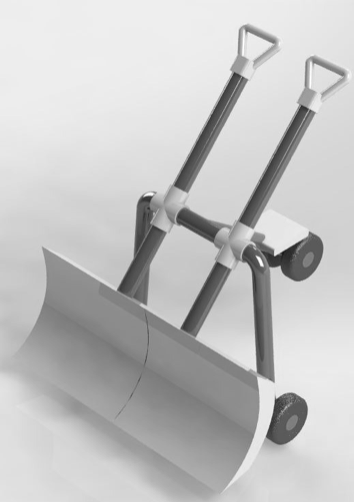
The Step Shovel has one wheel and one attached shovel. The design has a lower-body powered step that lifts the shovel and snow. The dumping on this design is done by twisting the entire mechanism like a wheelbarrow.
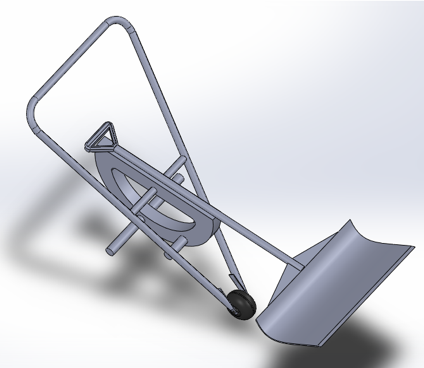
Harris Profile
A Harris Profile was used to evaluate the three designs. The Harris Profile facilitates decision-making by evaluating solutions with criteria related to the design goal (A.G.C, 139). Each solution was rated on design criteria with a four point scale (-2 = bad, -1 = moderately bad, +1 = moderately good, and +2 = good). The criteria are listed in sequence of priority, with the first being the most important and the last being the least important. The most important criterion was “Cost / easy to manufacture” because of the limited time we had to develop and evaluate early prototypes. The subsequent criteria were relating to back, arm, and shoulder functions. The most desirable design was the Single Swivel Shovel because it was expected to be easy to fabricate and effective for reducing the strain on the back, arm, and shoulder.
Prototoype
The Single Swivel Shovel was prototyped and tested in the lab. We named the design the Snow Stomper to signify that it is a removal tool that uses foot-action to lift the snow. The design includes the desirable features of a foot-powered lift and a mobile support structure.
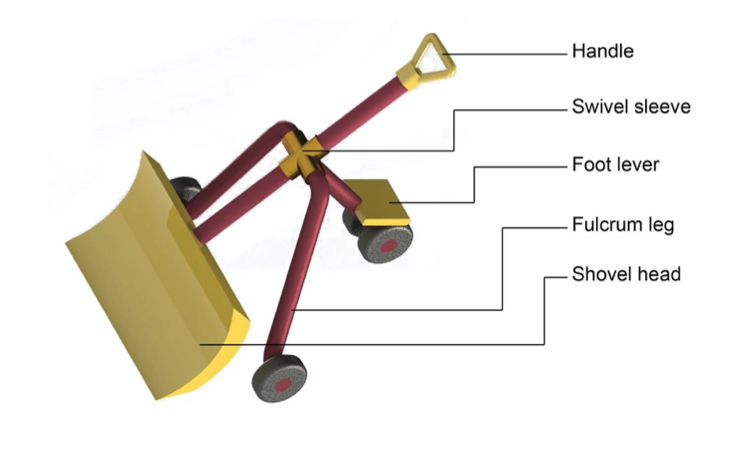
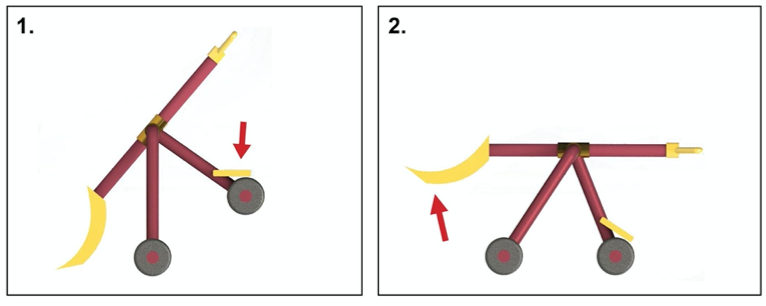
Testing
Participants
Five participants (1 female, 4 male) were gathered using a convenience sample of participants who live in the Midwest region of the United States. All participants had previously been involved in residential snow removal or were currently responsible for residential snow removal. No participants had been involved in commercial snow removal. Participants’ dominant hand was the right hand. Participants had ages 22-32 years (mean 25.8), weighed 65-84kg (mean 76kg), height 1.72-1.82 meters (mean 1.75m).
Materials
The study was conducted in a kinesiology lab that is equipped with Electromyography sensors (Delsys Inc., Boston, MA, USA), reflective sensors, and 12 Qualysis cameras (Qualysis Motion capture Systems AB, Gothenburg, Sweden).The Electromyography sensors are used to sense muscle energy. The reflective sensors are sensed by the infrared motion capture cameras track movement at a sampling frequency of 240 Hz. The sensible area was 20 feet wide.
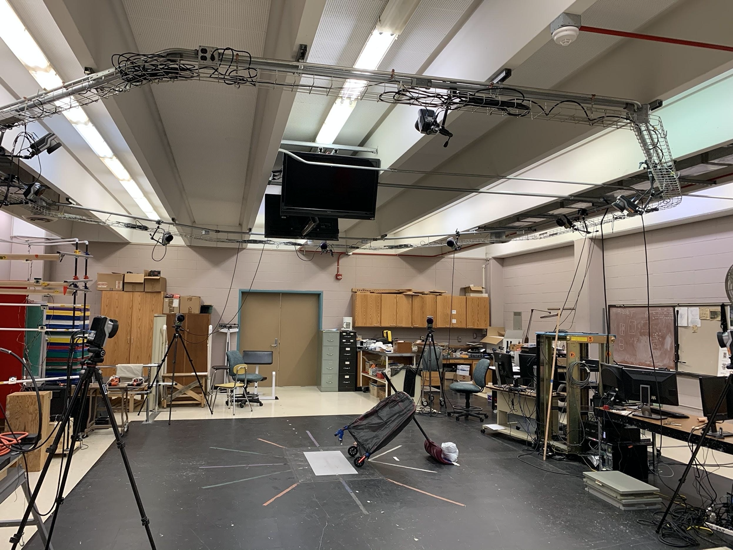
The snow-removal tools used for the activities were a conventional shovel (control) and the Snow Stomper (experimental). The conventional shovel had a wood handle and metal blade, and represents a common tool that would be found in households. The metal on the tools was covered with papers and plastics so that it would not interfere with the sensors. The weights used were corn bags of half and one pound weight increments placed in the scoop zone of each device.
Procedure
The participant was presented with the foreseeable risks and gave written consent. Participants were informed on the schedule of their participation, which included the collection of demographic information, the placement of electromyography (EMG) sensors, the activity with a shovel, and the activity with the new design. Participants were asked their demographic information including, age, sex, height, weight, and dominant hand/arm. Participants had EMG sensors placed on the dominant anterior deltoid, dominant biceps, right Erector Spinae, and Left Erector Spinae. Then the participants maximal voluntary isometric contraction (MVIC) was tested. Finally, retroreflective markers were placed on participants’ right and left acromion processes (shoulders), lateral epicondyles (elbows), radial tuberosities (wrists), L5 vertebrae and C7 (Cervicale). Additionally, one marker was placed on the tool. The marker position data was recorded using 12 Qualysis cameras (Qualysis Motion capture Systems AB, Gothenburg, Sweden), at a sampling frequency of 240 Hz.
Participants were informed about the activity of the first trial and the following questionnaire. The trials were counterbalanced so some participants did the shovel first and others did the Snow Stomper first. In the first trial, participants were instructed to use a tool to lift, hold for 5 seconds, and drop a weight (5% of their body weight). They practiced the procedure and researchers affirmed that the participants conducted appropriate procedures. After the practice, the participants conducted the shovel procedure with three repetitions. After the three repetitions the participant was asked the post-condition questionnaire (See Appendix 2).
Participants were informed about the activity of the second trial and the following questionnaire, which is the same as the first trial. In the second trial, participants were instructed to use the other tool to lift, hold for 5 seconds, and drop a weight (5% of their body weight). They were instructed to practice the procedure and researchers affirmed that the participants conducted appropriate procedures. After the practice, the participants conducted the new design procedure with three repetitions. After the three repetitions the participant was asked the post-condition questionnaire.
Kinematic data were low pass filtered with a cut off frequency of 15 Hz. EMG data was rectified and band pass filtered using cut off frequencies of 20 and 450 Hz., using a zero lag 4th order butterworth filter. Matlab 2019b package was used for data processing (Matlab, Mathworks). The EMG data were normalized to the MVIC values.
Hyphotheses
The two hypotheses address the biomechanical and subjective measures of participants use of the shovel and Snow Stomper
H1: Users of the Snow Stomper will experince lower measures of force, joint moment, and muscle activity when cmpared to baseline.
H2: Users of the Snow Stomper will experince higher levels of comfort and performance when compared to the baseline
Analysis
The data was analyzed using paired t-tests with .05 significance level.
Results
Muscle activity and Joint Moment
H1 was partially supported. The muscle activity in the lower back decreased with the use of the snow stomper and the muscle activity in the leg increased with the use of the snow stomper. The results were not significant, but they were in the desired direction. Increasing the number of partiicpants would likely produce significant results. The joint moment for the L5S1 joint (back) increased with the use of the snow stomper but the increase was not significant. This is not the result we want to see, so we must redesign to decrease joint moment.
Comfort and Performance
H2 was partially supported. All 5 Particpants reported that it felt more comfortable to use than the standard shovel in the shoulders, arms, and back. Participants did not report any preference toward the snow stomper in ratings of performance. This is likely because they are accustomed to the shovel, and our prototype is not yet production quality.
Limitations
The evaluation used laboratory procedures to identify specific muscles and analyze how they are engaged during the process of snow removal. The evaluation had limitations that influence its generalizability to the activity of shoveling. First, we were only able to secure participants between the ages of 22 and 32. These participants were used because they were accessible in a short time frame and located within a 30-minute travel distance of the laboratory. Second, the experimental procedure used a bagged corn-kernel weight instead of naturally occurring snow or a loose material that mimics naturally occurring snow. Third, our experiment was run with three repetitions which is fewer than the number of repetitions in a typical snow removal session.
Recommendations
Further deisgn work can decrease the joint moment in the lower back (L5S1 joint). The lower back momeent can be decreased, but it will take work with expertise in kinesiology, human factors, and enginnering to design an appropriate solution for the Snow Stomper. Further evaluations of the Snow Stomper could investigate a broader scope of testing with varying independent variables such as a variety of load weights representing several snow densities and a variety of repretition sequences. Generally speaking, the Snow Stomper is a promising solution to the design problem, and work in this direction should continue.
References
- A.G.C. van Boeijen, J.J. Daalhuizen, J.J.M. Zijlstra and R.S.A. van der Schoor (eds.) (2013) Delft Design Guide. Amsterdam: BIS Publishers. 138-139.
- Anderson, C. K., & Chaffin, D. B. (1986). A biomechanical evaluation of five lifting techniques. Applied Ergonomics, 17(1), 2–8. https://doi.org/10.1016/0003-6870(86)90186-9
- Andersson GBJ. (1999). Epidemiological features of chronic low-back pain. Lancet, (354), 581–585.
- Aqua-calc.com. Density of Corn, shelled (material). Accessed: https://www.aqua-calc.com/page/density-table/substance/corn-coma-and-blank-shelled
- Bazrgari, B., Shirazi-Adl, A., & Arjmand, N. (2007). Analysis of squat and stoop dynamic liftings: muscle forces and internal spinal loads. European Spine Journal, 16(5), 687–699. https://doi.org/10.1007/s00586-006-0240-7
- Degani, A., Asfour, S. S., Waly, S. M. and Koshy, J. G. 1993. A Comparative Study of Two Shovel Designs. Applied Ergonomics, 24(5): 306–312.
- Eppinger, U. (2012). Product Design and Development. Irwin McGraw-Hill. 134-136
- Marras, W. S. (2000). Occupational low back disorder causation and control. Ergonomics, 43(7), 880–902. https://doi.org/10.1080/001401300409080
- OSHA 1910.25 - Walking-Working Surfaces -Stairways https://www.osha.gov/laws-regs/regulations/standardnumber/1910/1910.25
- Punnett, L., Prüss-Üstün, A., Nelson, D. I., Fingerhuf, M. A., Leigh, J., Tak, S. W., & Phillips, S. (2005). Estimating the global burden of low back pain attributable to combined occupational exposures. American Journal of Industrial Medicine, 48(6), 459–469. https://doi.org/10.1002/ajim.20232
- Sifre, P. (2015). Evaluating Snow Loads on Structures. Simpson Gumpertz & Heger. Accessed: http://www.sgh.com/sites/default/files/downloads/topic_brief_evaluating_snow_loads.pdf
- Stuart M. McGill , Leigh Marshall & Jordan Andersen (2013) Low back loads while walking and carrying: comparing the load carried in one hand or in both hands, Ergonomics, 56:2, 293-302, DOI: 10.1080/00140139.2012.752528
- Watson, D.S., Shields, B.J., Smith, G.A., (2011). Snow shovel-related injuries and medical emergencies in US EDs, 1990 to 2006. Am. J. Emerg. Med. 29 (1),11-17